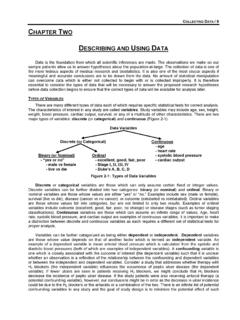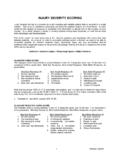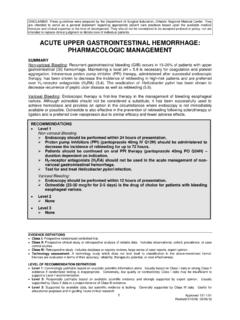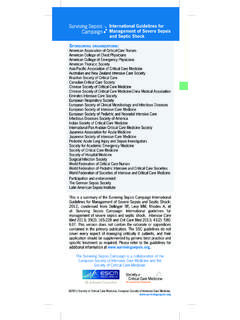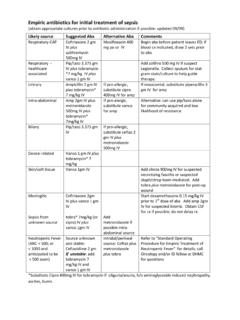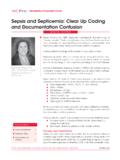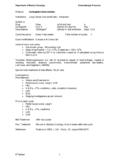Transcription of EMPIRIC ANTIBIOTIC USE IN CRITICALLY ILL PATIENTS
1 DISCLAIMER: These guidelines were prepared by the Department of Surgical Education, Orlando Regional Medical Center. They are intended to serve as a general statement regarding appropriate patient care practices based upon the available medical literature and clinical expertise at the time of development. They should not be considered to be accepted protocol or policy, nor are intended to replace clinical judgment or dictate care of individual PATIENTS . EMPIRIC ANTIBIOTIC selection should be based on local susceptibility patterns of microorganisms. 1 Approved 5/08/2007 EMPIRIC ANTIBIOTIC USE IN CRITICALLY ILL PATIENTS SUMMARY Inappropriate EMPIRIC ANTIBIOTIC therapy is widespread and associated with increased mortality in CRITICALLY ill PATIENTS . Initial ANTIBIOTIC selection must account for a variety of host, microbiologic, and pharmacologic factors.
2 Institution-specific data, such as susceptibility patterns, must also be considered. Tailoring antimicrobial therapy based upon culture and sensitivity results will help to reduce costs, decrease the incidence of superinfection, and minimize the development of resistance. INTRODUCTION Inappropriate EMPIRIC ANTIBIOTIC therapy is widespread and associated with increased mortality in CRITICALLY ill PATIENTS . Although published consensus statements can provide general concepts by which to guide EMPIRIC ANTIBIOTIC selection, they are limited by a failure to incorporate local pathogen susceptibility patterns. There is considerable variability in the frequency of infections, spectrum of potential pathogens, and susceptibility patterns between different ICU s as well as subsets of PATIENTS within the same ICU. Several factors must be considered when selecting EMPIRIC antimicrobial therapy: Patient-specific factors Presumed source of infection ( , blood, sputum, urine, intra-abdominal) Presence of co-morbid conditions ( , recent surgery or trauma, chronic illness) Previous ANTIBIOTIC administration history Microbiological factors Identification of the most likely pathogens and their unit-specific susceptibility patterns Pharmacologic factors Potential drug toxicity ( aminoglycosides) Bioavailability Distribution to the site of infection RECOMMENDATIONS Level 1 None Level 2 Direct EMPIRIC antimicrobial selection at the most likely source of infection based upon clinical and microbiological data.
3 Perform a risk assessment for the presence of multi-drug resistant organisms by reviewing the patient s prior microbiologic data and antimicrobial use. Consider initiating antifungal therapy in PATIENTS at risk (see Management of Candida Infections in Surgical PATIENTS guideline). Select combination therapy with agents from different classes for initial gram-negative coverage to increase the likelihood of susceptibility. Level 3 Perform focused diagnostic tests and procedures according to the Fever Assessment Guidelines . For PATIENTS with severe sepsis , initiate EMPIRIC antimicrobial agents within one hour. Tailor antibiotics based on culture and susceptibility results. For gram-negative infections, there is insufficient evidence to support routine combination therapy to achieve synergy or prevent resistance. In the absence of a clear survival advantage to combination gram-negative coverage, the decision to tailor ANTIBIOTIC administration to monotherapy should be based on patient-specific factors.
4 2 Approved 5/08/2007 Any EMPIRIC ANTIBIOTIC regimen should be reassessed and tailored as soon as culture and sensitivity results become available. This practice serves to reduce costs, decrease the incidence of superinfection and minimize the development of antimicrobial resistance. The EMPIRIC use of vancomycin deserves special consideration. Widespread antimicrobial therapy with this agent has contributed to a significant increase in vancomycin-resistant enterococcal (VRE) infections. The potential transfer of resistance to more virulent organisms such as Staphylococcus aureus and Staphylococcus epidermidis poses a significant public health threat. As a result, the Centers for Disease Control (CDC) has published recommendations for the prudent use of vancomycin in a document addressing the prevention and control of resistance (1).
5 LITERATURE REVIEW Early Appropriate Antimicrobial Therapy A recent focus regarding antimicrobial therapy emphasizes the importance of early initiation of appropriate ANTIBIOTIC therapy. Delays in effective antimicrobial coverage are associated with a detrimental impact on patient morbidity and mortality, with an increased risk of sepsis , higher costs, and increased ventilator days for PATIENTS with ventilator-associated pneumonia (VAP) (2). Tailoring of antibiotics once cultures are available may not compensate for initial inadequate therapy (Class II). In a prospective, cohort study of CRITICALLY ill PATIENTS , the relationship between inappropriate EMPIRIC antimicrobial therapy and outcome was evaluated (3). Multivariate analysis demonstrated that inadequate antimicrobial treatment of nosocomial infections was a risk factor for hospital mortality (adjusted OR ; p< ).
6 VAP and bloodstream infections accounted for 89% of inadequately treated nosocomial infections. The most common gram positive and gram-negative organisms associated with inadequately treated VAP were oxacillin-resistant Staphylococcus aureus and Pseudomonas aeruginosa, respectively. Candida species were the most common organisms responsible for inadequate treatment of bloodstream infections (Class II). Combination therapy does increase the likelihood of appropriate therapy for multi-drug resistant (MDR) pathogens. Therefore, initial coverage should include agents from different classes. Gram-negative coverage typically involves a -lactam, fluoroquinolone or aminoglycoside. Quinolones demonstrate better lung penetration and less renal toxicity as compared to aminoglycosides. However, there is evidence supporting a trend towards increased survival with aminoglycoside-containing regimens (4) (Class II).
7 For PATIENTS with severe sepsis , it is recommended that intravenous ANTIBIOTIC therapy be started within the first hour of recognition of severe sepsis , after appropriate cultures have been obtained (5) (Class III). Risk Factors for Multi-drug Resistant (MDR) Pathogens When selecting EMPIRIC antimicrobial therapy, an assessment for risk of infection with MDR organisms must be made. Risk factors include admission following recent hospitalization or residency in a healthcare-associated facility. Additionally, PATIENTS who develop symptoms after five days of hospitalization and/or mechanical ventilation are also at risk for MDR pathogens. Trouillet and colleagues noted a series of variables increasing the risk for MDR VAP. These include a duration of mechanical ventilation greater than seven days, prior ANTIBIOTIC use, and broad-spectrum antimicrobial therapy, specifically, third-generation cephalosporins, fluoroquinolones and carbapenems (6) (Class II).
8 Combination versus monotherapy Combination therapy has been advocated to achieve synergy against Pseudomonas aeruginosa and to prevent the emergence of multi-drug strains. However, this practice remains controversial. Synergy has been demonstrated to be valuable in neutropenic or bacteremic PATIENTS (7) (Class II). A meta-analysis of prospective, randomized trials comparing the treatment of sepsis with -lactam monotherapy or with a -lactam and aminoglycoside combination regimen failed to demonstrate a significant benefit for 3 Approved 5/08/2007 combination therapy (8) (Class II). Of the 7,586 PATIENTS evaluated, 1,200 had sepsis from VAP or hospital-associated pneumonia (HAP). No advantage was found with combination therapy for the treatment of Pseudomonas aeruginosa.
9 Combination therapy did not prevent the development of MDR strains and the use of aminoglycosides resulted in higher rates of nephrotoxicity. A summary of studies addressing this issue is provided in the table below. Author Hilf et al. (7) Leibovici et al. (9) Study Design Prospective, multicenter study of consecutive PATIENTS (Class II) Prospective, observational (Class II) Population P. aeruginosa bacteremia including neutropenic PATIENTS (27%) Gram (-) bacteremia (single organism) including neutropenic PATIENTS Comparison(s) Combination ( -lactam + AG) vs. monotherapy Combination ( -lactam + AG) vs. monotherapy ( -lactam or AG) Comparisons were made for appropriate EMPIRIC & definitive therapy Results 200 PATIENTS 93% received anti-pseudomonal therapy 70% received combination therapy No correlation between results of in vitro susceptibility & synergy testing and outcome were found Mortality: Combo (27%) vs.
10 Mono (47%); p= 2165 PATIENTS Mortality ( EMPIRIC therapy) Combo (19%) vs. -lactam (17%); p=NS. Combo (19%) vs. AG (24%); p< Mortality (Definitive therapy) Combo (15%) vs. -lactam (13%); p=NS Combo (15%) (23%); p< Mortality ( -lactam vs AG) Higher mortality in all strata with AG except UTI Author s Conclusions The use of combination therapy rather than monotherapy for bacteremia caused by P. aeruginosa is associated with improved survival. Mortality rates for non-neutropenic PATIENTS treated with combination therapy and those given a single -lactam were similar. Treatment with an AG as a single agent was associated with a higher mortality than treatment with a -lactam (except in PATIENTS w/ UTI). Author Siegman-Igra, et al. (10) Crabtree, et al. (11) Study Design Retrospective (Class III) Prospective, observational (Class II) Population P. aeruginosa bacteremia including neutropenic PATIENTS (11%) Surgical PATIENTS with gram (-) infection including general surgery, trauma & transplant PATIENTS Comparison(s) Combo=fluoroquinolone OR 3rd generation cephalosporin OR imipenem-cilastatin + AG Monotherapy= fluoroquinolone OR 3rd generation cephalosporin OR imipenem-cilastatin AG containing regimen vs.


